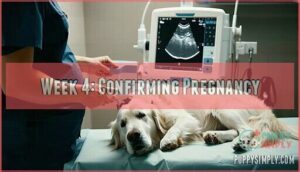This site is supported by our readers. We may earn a commission, at no cost to you, if you purchase through links.

Small breeds often reach sexual maturity earlier, while larger breeds may not cycle until they’re two years old.
Female dogs go into heat roughly every six months, and they’re fertile during this three-week period.
However, just because your pup can get pregnant doesn’t mean she should – breeding too young can lead to serious complications for both mom and puppies.
Think of it like teenage pregnancy in humans – physically possible but not ideal.
Understanding your dog’s heat cycle timing and recognizing the early warning signs can help you make informed decisions about her reproductive health.
Table Of Contents
- Key Takeaways
- Dog Pregnancy Basics
- When Can Dogs Get Pregnant
- Heat Cycles and Fertility
- Risks of Early Breeding
- Signs of Heat and Pregnancy
- Breeding and Pregnancy Timeline
- Preventing Unwanted Pregnancy
- Frequently Asked Questions (FAQs)
- When can a dog get pregnant?
- Can a female dog get pregnant?
- When does a dog give birth?
- Can dogs get pregnant at 10 months?
- How does a dog get pregnant?
- When does a dog have a fetus?
- When can a dog get pregnant after bleeding?
- Can dogs get pregnant when not in heat?
- When can a female dog safely get pregnant?
- How soon can pregnancy be detected in dogs?
- Conclusion
Key Takeaways
- **Your dog can technically get pregnant as early as 6 months during her first heat cycle, but you shouldn’t breed her until she’s fully mature – typically after her second or third cycle, around 18-24 months old.
- **You’ll need to understand that your dog’s heat cycle happens every 6 months and lasts 2-3 weeks, with the middle stage, called estrus, being when she’s most fertile and can conceive.
- **Breeding too early creates serious health risks, including difficult births, stunted growth, and developmental problems for both mom and puppies – it’s like teenage pregnancy in humans.
- **If you’re not planning to breed, spay your dog before her first heat cycle, or contact your vet immediately after accidental mating, since emergency measures, like mismating shots, work within 2-5 days.
Dog Pregnancy Basics
You’ll need to understand the difference between when your dog can physically get pregnant and when she should get pregnant for her health and safety.
While female dogs can become pregnant as early as their first heat cycle around six months old, responsible breeding requires waiting until they’re fully mature, which typically means after their second or third cycle, for her health and safety.
Smart breeding means patience – your dog’s body needs time to fully develop before she’s ready for motherhood.
Sexual Maturity in Dogs
Sexual maturity marks the beginning of your dog’s reproductive journey, but timing varies dramatically by breed size.
Small breeds often reach dog puberty age around four months, while giant breeds may wait until two years.
Your female dog’s first heat signals sexual maturity, yet this doesn’t mean she’s ready for breeding.
Physical growth continues long after the dog reproductive cycle begins, making veterinary consultation essential to determine when your dog is physically and reproductively ready, highlighting the importance of physical growth.
Physical Maturity and Breeding
Beyond reaching sexual maturity, your dog needs complete physical development before breeding becomes safe.
Growth vs. maturity represents two different timelines, especially considering breed size impact on development rates.
Key factors for ideal timing include:
- Genetic screening to identify hereditary issues
- Veterinary assessment of physical readiness
- Waiting until second heat cycle
- Ensuring full skeletal development completion
Smart breeding means patience pays off.
Importance of Veterinary Consultation
Professional guidance makes all the difference when planning dog breeding.
Your veterinarian will assess breeding health through genetic screening, evaluate pregnancy risks, and determine if your dog’s ready. They’ll provide expert advice throughout the process, from pre-breeding checkups to whelping assistance and postnatal care.
This veterinary care guarantees both mother and puppies stay healthy during this critical time, ensuring that they receive the necessary care to thrive, with professional guidance being key to a successful breeding process.
When Can Dogs Get Pregnant
Most female dogs can technically get pregnant during their first heat cycle, which typically occurs between 6-18 months depending on dog breeding age and breed size.
However, first cycle pregnancy isn’t recommended due to physical maturity importance and long-term health concerns.
Here’s when dogs are fertile:
- Small breeds: 4-6 months old
- Medium breeds: 6-12 months old
- Large breeds: 12-18 months old
- Giant breeds: 18-24 months old
- All breeds: Every 6-7 months after dog first heat
Ethical considerations suggest waiting until full maturity before breeding. A healthy pregnancy requires understanding dog gestation stages.
Heat Cycles and Fertility
Your dog’s heat cycle happens about every six months and lasts two to three weeks, with the middle stage called estrus being when she’s most likely to get pregnant.
Understanding these cycles helps you plan breeding timing or prevent unwanted pregnancies, since sperm can survive in her body for up to a week during her fertile window.
Stages of Heat Cycle
Your dog’s heat cycle unfolds in four distinct stages.
Proestrus signs include vulva swelling and bleeding, lasting 3-17 days. Next comes estrus behavior changes – she’ll become receptive to males for 3-21 days.
Diestrus length spans 60-90 days of decreased fertility. Finally, anestrus duration lasts 100-150 days of sexual inactivity.
Dog heat cycle length varies substantially between individual dogs.
Identifying Optimal Breeding Times
Timing is everything in the context of successful breeding.
Peak fertility occurs between days 10-14 of your dog’s estrus cycle, though cycle length variation means this window can shift.
Progesterone testing provides the most accurate way to pinpoint when dogs are fertile, while experienced breeders often rely on ovulation signs like changes in vaginal discharge consistency and your dog’s receptive behavior.
Responsible breeders also prioritize thorough health screenings for genetic conditions, ensuring a thorough approach to breeding, with responsible decisions, and considering genetic conditions.
Fertility Window and Sperm Survival
Understanding when dogs are fertile requires knowing how long sperm survives in their system.
Male dogs’ sperm can live up to seven days inside the female’s reproductive tract, extending the fertile window well beyond ovulation timing.
This sperm lifespan means your dog can get pregnant for up to ten days after estrus begins, even when fertile discharge changes from bloody to watery during the dog ovulation cycle.
Some dogs may experience infertility due to uterine infections or hormonal conditions.
Risks of Early Breeding
Breeding your dog too early can create serious health problems for both the mother and her puppies, since her body isn’t fully developed yet.
You’ll face complications during pregnancy and birth, plus the puppies may have developmental issues that could affect them throughout their lives, which is a serious health problem.
Complications During Pregnancy
When breeding occurs too early, you’re rolling the dice with serious dog pregnancy complications.
When you breed too early, you’re gambling with your dog’s life and her puppies’ future.
Dystocia management becomes critical as young mothers struggle with difficult births, while eclampsia risks and gestational diabetes threaten their lives.
Maternal infections can develop rapidly, and canine pregnancy complications multiply when the mother’s body isn’t ready.
These dog health risks make timing absolutely vital, as dystocia management is crucial in preventing serious complications.
Health and Developmental Issues
Beyond birth complications, early breeding creates serious dog health risks that ripple through generations.
Young mothers face stunted growth as their bodies divert energy to developing puppies instead of their own maturation.
This leads to lasting dog health problems, including increased genetic problems in offspring, and behavioral issues often emerge.
Compromised maternal health affects puppy health throughout their lives, leading to a lasting impact on the overall dog health.
Long-term Implications for Mother and Offspring
Early breeding creates a ripple effect that lasts years.
Your dog faces increased mammary cancer risks and genetic predispositions passing to puppies.
Maternal health suffers from stunted growth, while behavioral impacts include anxiety and aggression.
Puppy development gets compromised, leading to lifelong health problems.
These lifespan effects make dog breeding risks far outweigh benefits when timing’s wrong, due to the significant impact on genetic predispositions.
Signs of Heat and Pregnancy
You’ll notice several clear signs when your dog enters heat, including vulva swelling, bloody discharge, and increased male attention.
Recognizing these changes, along with early pregnancy symptoms like behavioral shifts and physical changes, helps you make informed decisions about your dog’s reproductive health.
Physical Changes and Behavioral Signs
Pregnancy transforms your dog’s body and behavior in unmistakable ways.
You’ll notice these key dog pregnancy signs as early as week three:
- Vulva Swelling and enlarged nipples signal hormonal changes
- Appetite Changes ranging from increased hunger to morning sickness
- Lethargy Signs including decreased energy and more frequent napping
- Milk Production beginning around week four of pregnancy
To confirm suspicions, consider using a dog pregnancy test.
False Pregnancy Symptoms
Sometimes your dog might experience a phantom pregnancy after her heat cycle, even without mating.
This hormonal imbalance tricks her body into mimicking real pregnancy signs. You’ll notice nesting behaviors like gathering blankets, lactation signs including swollen nipples, and treating toys like puppies.
These false pregnancy symptoms typically resolve within three weeks, though treatment options exist if needed. Many owners seek products for this condition to help manage symptoms.
Detecting Pregnancy Through Tests
Multiple dog pregnancy tests can confirm whether your furry friend is expecting.
Your veterinarian has several reliable options for dog pregnancy diagnosis:
- Abdominal palpation around day 30 requires expert hands to feel developing puppies
- Serological tests detect pregnancy hormones by week three with high accuracy
- Ultrasound accuracy peaks at 25 days, providing visual confirmation safely
Human tests won’t work, but radiography use helps count puppies later.
Preparing a safe whelping box is also essential as the pregnancy progresses.
Breeding and Pregnancy Timeline
You’ll want to understand what happens during each week of your dog’s pregnancy to properly care for her and prepare for the puppies.
The first four weeks bring subtle but important changes, from fertilization and implantation to the earliest signs you can actually notice.
Week 1-2: Early Changes and Hormonal Shifts
During the first two weeks after mating, your dog’s body undergoes significant hormonal changes as the fertilization process begins.
You might notice initial lethargy or subtle appetite changes as implantation timing occurs. These behavioral indicators are often mild, making early dog pregnancy symptoms easy to miss.
It may be beneficial to research dog pregnancy supplements during this time. The canine pregnancy symptoms during this dog pregnancy week-by-week phase focus primarily on internal development rather than visible changes, which can be influenced by dog pregnancy vitamins and the overall canine pregnancy.
Week 3: Early Symptoms Start
By week three, your dog’s body starts dropping hints about her condition.
You’ll notice an increased appetite as her nutritional needs begin shifting, along with possible morning sickness episodes.
Subtle weight gain may appear, though it’s often minimal.
Behavioral changes become more apparent – she might seek extra affection or seem unusually clingy, signaling early dog pregnancy symptoms developing, which can include morning sickness episodes and nutritional needs.
Week 4: Confirming Pregnancy
By week four, your dog’s pregnancy becomes detectable through professional veterinary methods.
Multiple testing options provide reliable confirmation, though palpation accuracy varies between practitioners.
- Ultrasound usage around day 25 offers the safest, most common diagnostic approach for canine pregnancy
- Serological testing delivers reliable hormone differences detection by week three of dog pregnancy
- Radiography timing from day 44 helps estimate litter size and detect abnormalities
- Veterinary checkups guarantee proper diagnosis through professional tests rather than guesswork
Preventing Unwanted Pregnancy
If you’re not planning to breed your dog, preventing unwanted pregnancy becomes your top priority to avoid the stress and expense of surprise puppies.
You’ll need to understand your options, from spaying and neutering to emergency measures, because even the most careful pet owners can face unexpected situations when their dog’s heat cycle catches them off guard.
Spaying and Neutering
Spaying and neutering remain your most effective tools for preventing unwanted pregnancies.
These procedures offer significant health benefits beyond population control, including reduced cancer risks and behavioral improvements.
Here’s what you need to know about timing and benefits:
| Procedure | Best Timing | Key Benefits |
|---|---|---|
| Spaying (Female) | Before first heat cycle (6 months) | Eliminates heat cycles, prevents uterine infections |
| Neutering (Male) | 6-12 months | Reduces aggression, prevents testicular cancer |
| Large Breeds | After first heat | Supports proper bone development |
Responsible Breeding Practices
Beyond surgical prevention, responsible breeding requires careful planning and ethical considerations.
You’re taking on substantial responsibilities when breeding dogs, from genetic screening to lifelong commitment.
Consider these breeding responsibilities before making decisions:
- Genetic screening prevents hereditary diseases in future generations
- Breeder education guarantees you understand canine breeding ethics completely
- Puppy socialization requires months of dedicated time and effort
- Finding suitable homes means screening potential families thoroughly
- Lifelong commitment includes supporting puppy owners with guidance
Dog breeding best practices demand serious consideration of these challenges.
Being a responsible dog owner involves substantial financial commitment.
Emergency Measures After Accidental Mating
Accidents happen, and when your dog’s unplanned romance leads to unexpected dog pregnancy concerns, quick action matters.
Contact your veterinarian immediately for post-mating care options. Mismating shots can prevent pregnancy if given within days, while spay abortion remains effective shortly after breeding.
| Immediate Actions | Timing |
|---|---|
| Veterinary consultation | Within 24-48 hours |
| Mismating shots | 2-5 days post-mating |
| Pregnancy termination via spaying | Up to 4 weeks |
Your vet will guide you through preventing dog pregnancy based on your dog’s specific situation and health status.
Frequently Asked Questions (FAQs)
When can a dog get pregnant?
Like nature’s own calendar, your dog’s reproductive window opens around six months old during her first heat cycle.
However, you shouldn’t breed her until she’s fully mature—typically after her second or third cycle.
Can a female dog get pregnant?
Yes, female dogs can get pregnant once they reach sexual maturity, typically between 4-24 months depending on breed size.
They’re fertile during heat cycles, which occur every six months throughout their lives.
When does a dog give birth?
Like clockwork, your dog’s pregnancy journey lasts approximately 63 days from conception to delivery.
You’ll notice labor signs including restlessness, nesting behavior, and temperature drops before she welcomes her puppies into the world.
Can dogs get pregnant at 10 months?
Most dogs can get pregnant at 10 months, but it’s not recommended.
While they’re sexually mature, they’re not physically ready.
Wait until their second heat cycle for healthier pregnancies and stronger puppies.
How does a dog get pregnant?
Ironically, nature’s process is quite straightforward.
Your female dog becomes pregnant when sperm from a male dog fertilizes her eggs during her fertile estrus period, typically occurring during her heat cycle.
When does a dog have a fetus?
Your dog develops a fetus approximately 21 days after conception, when the embryo implants into the uterine wall.
This marks the beginning of true fetal development, occurring roughly three weeks into pregnancy.
When can a dog get pregnant after bleeding?
After bleeding stops, your dog enters her most fertile period.
She can get pregnant immediately once the discharge becomes watery and light pink, which typically happens within days of bleeding ending.
Can dogs get pregnant when not in heat?
Fertility’s fundamental fact: your female dog can’t conceive when she’s not in heat.
No eggs are released outside her heat cycle, making pregnancy impossible.
You’ll need to wait for her next cycle for breeding opportunities.
When can a female dog safely get pregnant?
Your female dog can safely get pregnant after her second or third heat cycle, typically around 18-24 months old.
Wait until she’s physically mature to avoid complications for both mom and puppies.
How soon can pregnancy be detected in dogs?
You can detect pregnancy in your dog as early as 23-30 days after mating through abdominal palpation, though ultrasound around day 25 provides the most reliable confirmation for expecting pet parents.
Conclusion
Knowledge is power regarding your dog’s reproductive health.
Understanding at what point dogs get pregnant helps you make informed decisions about breeding or prevention.
While dogs can conceive as early as six months, waiting until full maturity guarantees safer pregnancies.
Monitor your dog’s heat cycles, watch for early signs, and consult your veterinarian for personalized guidance.
Whether you’re planning puppies or preventing them, proper timing and professional advice will keep your furry friend healthy and happy.
- https://shelleydriveanimalclinic.net/blog/244280-what-is-the-best-age-for-a-dog-to-get-pregnant
- https://www.akc.org/expert-advice/dog-breeding/how-long-are-dogs-in-heat/
- https://vcahospitals.com/know-your-pet/estrus-cycles-in-dogs
- https://www.pawsinhand.co.uk/blog/everything-you-wanted-to-know-about-the-female-season
- https://www.petmd.com/dog/general-health/dog-in-heat















